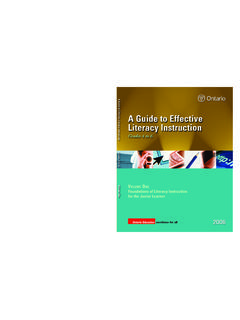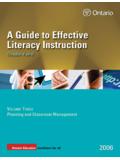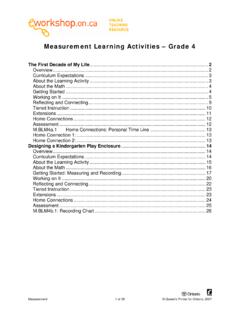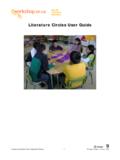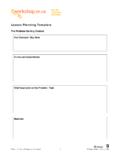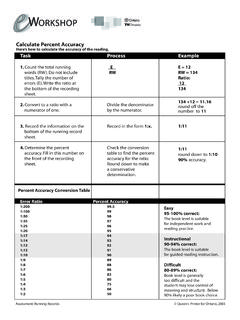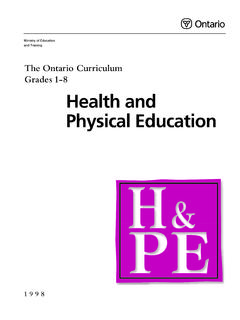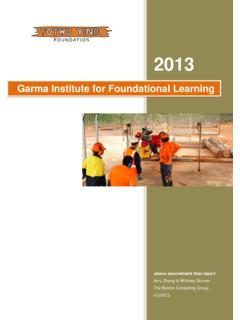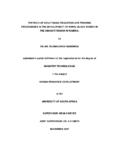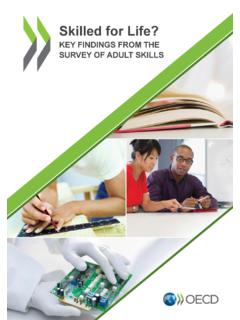Transcription of A Guide to Effective Literacy Instruction, Grades 4 to 6
1 A Guide to EffectiveLiteracy Instruction, Grades 4 to 6A Guide to EffectiveLiteracy Instruction, Grades 4 to 6A Multi-volume Resource from the Ministry of EducationVOLUMESEVENM edia 1 The Organization of This Volume .. 2 Key Messages for Teachers and Students .. 2 Working Toward Equitable Outcomes for Diverse Students .. 4 Planning Language Programs for Students with Special Education Needs .. 5 CHAPTER1: ANOVERVIEW OFMEDIALITERACY IN 7 What Is Media Literacy ? .. 7 The Power of Media Literacy .. 10 Conditions for Media Learning .. 13 Content of Media Literacy Instruction .. 13 Media Literacy Skills .. 15 Teaching Media Literacy Across the Curriculum .. 16 Media Literacy Assessment .. 28 CHAPTER2: APPROACHES 33 Introduction .. 33 The Five Key Concepts of Media Literacy .. 34 The Media Triangle .. 38 Media Mini-Lesson .. 41 Simulations .. 42 Comparing, Sorting, and Classifying .. 43 Surveys, Media Logs, and Historical Perspectives .. 44 Dealing with Sensitive News Items and Issues.
2 46 CHAPTER3: 47 Detailed LessonsLesson #1 (Media Analysis): Deconstructing Movie Ads .. 49 Lesson #2 (Media Analysis): Detecting Bias in a Television Newscast .. 54 CONTENTSL esson #3 (Media Creation): Creating a Storyboard for a Public Service Announcement .. 63 Lesson #4 (Media Creation): Creating a Brochure .. 74 Lesson OutlinesLesson #5 (Media Analysis): Reading a Website .. 85 Lesson #6 (Media Analysis): Analysing Music Lyrics .. 88 Lesson #7 (Media Creation): Creating a Website .. 91 Lesson #8 (Media Creation): Designing a Movie Poster .. 96 RESOURCES 101A Guide to Effective Literacy Instruction, Grades 4 to 6is organized into several first three volumes provide the foundation for Effective Literacy instruction and literacylearning in the junior Grades . Subsequent volumes go more deeply into what to teach and how to teach it in order to help all students experience 7, Media Literacy , builds on the research findings and best practices in Literacyfor Learning: The Report of the Expert Panel on Literacy in Grades 4 to 6 in Ontario.
3 Itprovides a framework for the expectations in the Media Literacy strand of the Languagecurriculum (2006). It emphasizes the importance of developing a critical awareness ofthe media and describes Effective ways of teaching about and using media. Media literacyinstruction can be woven into all areas of the curriculum not only the learning expectationsin all the Language strands (Reading, Writing, Oral Communication, and Media Literacy )but also other curriculum subject areas. In the junior Grades , students look for relevance and meaning in what they are today s media-saturated world, media Literacy is highly relevant. Students need tolearn to view media messages with a critical and analytical eye as well as how to interactwith media responsibly. By exploring the howsandwhysof the media, students developan increased understanding of the media s unprecedented power to persuade and influence. The sample detailed lessons and lesson outlines in this volume involve students in theanalysis and creation of a variety of media texts.
4 Students determine the intent of themessages (why were they created?), deconstruct the various elements of the messages(how were they developed and disseminated?), and examine the messages from a socialjustice point of view (who benefits from them and who might they hurt?). The activitiesare designed to respond to junior students growing awareness of the world and takeinto account their diverse needs and interests. 1 INTRODUCTIONTHEORGANIZATION OFTHISVOLUMEThis volume is organized into three chapters. The first chapter provides an overview of media Literacy in the junior Grades and explains the importance of providing medialiteracy instruction in today s world; the second chapter describes in detail several usefulframeworks and strategies for teaching media Literacy in the junior classroom; and thethird chapter offers sample detailed lessons and lesson outlines covering a range of topics,from the analysis of movie advertisements and television newscasts to the creation of apublic service announcement and a simple website.
5 Based on the needs and experiencesof their students, teachers can be selective in using the sample lessons as models or asresources. In each detailed lesson and lesson outline, teachers use modelling, demonstration,guided practice, and support, as needed, to release gradually responsibility to studentsfor using their newly learned strategies and FORTEACHERS ANDSTUDENTSIn each volume of the Guide to Effective Literacy Instruction, teachers are reminded ofthe key messages, listed in the chart on page 3, that are intended to help them addressthe goals of the junior Literacy program. The key messages are fundamental ideas thatunderlie all the approaches, strategies, and tools described in this Guide . They answerthe question: Why am I teaching this material, in this way, to this group of students,at this time? Teachers can use these key messages to Guide their Guide TO Effective Literacy INSTRUCTION, Grades 4 TO 6 VOLUME SEVEN2 INTRODUCTION3 Key Messages for Teachers and StudentsThe Effective Literacy teacher in Grades 4to 6 understands that: Literacy instruction must be driven by equitableongoing instruction must be explicit and relevantto students instruction must be differentiated, inclusive, and respectful of all unique identities and diverse experi-ences can contribute greatly to a rich language is the foundation for , writing, talking, listening, thinking, viewing,and representing are reciprocal Literacy need to become proficient in multi-literacies , involving texts of all need to learn that their Literacy skills are transferable to all content learn best when they are motivated and actively engaged in their learning.
6 Explicit feedback given immediately after assessment leads to improved levels of gradually releasing responsibility for learningto students, teachers help students improve their learning and develop a greater level of students are encouraged to assess theirown work and set their own goals, they take ownership of their Literacy experiences help studentsdevelop skills and attitudes that will serve themthroughout their lives and improve the quality oftheir skills give students a growingawareness of themselves as learners andoffer them more and critical- Literacy skills are tools students need in order to develop intoactive, responsible participants in the global collaboration and ongoing learninghelp teachers develop a deeper, broader, morereflective understanding of Effective successful student in Grades 4 to 6 understands that:Assessments are a way for the teacher and forme to understand how well I am learn best when I am reading and writing for a real tasks will be difficult, but I can learn thestrategies that I need to have valuable knowledge and experiences that I can share with my talk helps me to improve my reading,writing, and will make me a better writer, and writingwill make me a better reader.
7 Talking, listening, andthinking will make me a better reader and need to use my Literacy skills to work with textsof all can apply the strategies and skills that I learn in language to all I am actively involved in making meaning when I read and write, I will improve my teacher s feedback will help me to improvemy strategies I am learning will help me becomea proficient and independent reader, writer, need to think about my learning and to set goals. Knowing how to read, write, and communicateeffectively will help me be successful during myschool years and in my future about my thinking will help me understandwhat I have learned, make decisions about mylearning, and become a more independent need to think critically about all the texts Iencounter and to ask myself questions about theaccuracy and fairness of the stories or informationin these with others gives me new ideas andhelps me to reflect on and expand my own thinkingand FORDIVERSESTUDENTSAll students, whatever their socioeconomic, ethnocultural, or linguistic background,must have opportunities to learn and to grow both cognitively and socially.
8 When studentssee themselves reflected in what they are learning and when they feel secure in theirlearning environment, their true potential will be reflected in their achievement. Acommitment to equity and inclusive instruction in Ontario classrooms is therefore critical for enabling all students to succeed in school and, consequently, to become productive and contributing members of create the right conditions for learning, teachers must take care to avoid all forms of bias and stereotyping in resources and learning activities, which can quickly alienatestudents and limit their ability to learn. Teachers should be aware of the need to providea variety of experiences and multiple perspectives so that the diversity of the class isrecognized and all students feel respected and valued. Learning activities and resourcesfor teaching language should be inclusive, provide examples and illustrations, and useapproaches that reflect the range of experiences of students with diverse backgrounds,abilities, interests, and learning following are some strategies for creating a learning environment that recognizesand respects the diversity of students and allows them to participate fully in the learning experience: providing opportunities for media analysis and creation that are meaingful to all students ( , using media texts that reflect students interests, home life experiences, and cultural backgrounds); using multimedia resources that reflect diverse ethnocultural groups, includingAboriginal Peoples; using media content that reflects various cultures and customs.
9 Respecting customs and adjusting teaching strategies, as necessary for example, astudent may come from a culture in which it is considered inappropriate for a childto ask for help, express opinions openly, or make direct eye contact with an adult; considering the appropriateness of references to holidays, celebrations, and traditions; providing clarification as to whether the context of a learning activity is unfamiliarto students ( , describing or showing a food item that may be new to some students); evaluating the content of media texts ( , posters, advertisements, commercials,videos, website texts) for cultural bias; designing learning and assessment activities that allow students with various learningstyles ( , auditory, visual, tactile/kinaesthetic) to participate meaningfully;A Guide TO Effective Literacy INSTRUCTION, Grades 4 TO 6 VOLUME SEVEN4 providing opportunities for students to work both independently and with others; providing opportunities for students to communicate orally and in writing in theirhome language ( , pairing English-language learners with a first-language peerwho also speaks English).
10 Using diagrams, pictures, manipulatives, and gestures to clarify vocabulary that maybe new to English-language a full discussion of equity and diversity in the classroom, as well as a detailed checklistfor providing inclusive language instruction, see pages 1 and 3 8 in Volume Three of A Guide to Effective Literacy FORSTUDENTS WITHSPECIALEDUCATIONNEEDSP lanning language programs to provide differentiated instruction and assessment forstudents with special education needs is a fundamental aspect of inclusive a detailed discussion of the considerations involved in planning programs for students with special education needs, including the provision of accommodations and modified expectations, see the following: Volume Three of this Guide , Planning and Classroom Management, pages 9 10; Education for All: The Report of the Expert Panel on Literacy and Numeracy Instructionfor Students with Special Education Needs, Kindergarten to Grade 6, 2005, pages 117 122; The Ontario Curriculum, Grades 1 8: Language, 2006, pages 24 OFMEDIALITERACY INTHEJUNIORGRADES1 WHATISMEDIALITERACY?
